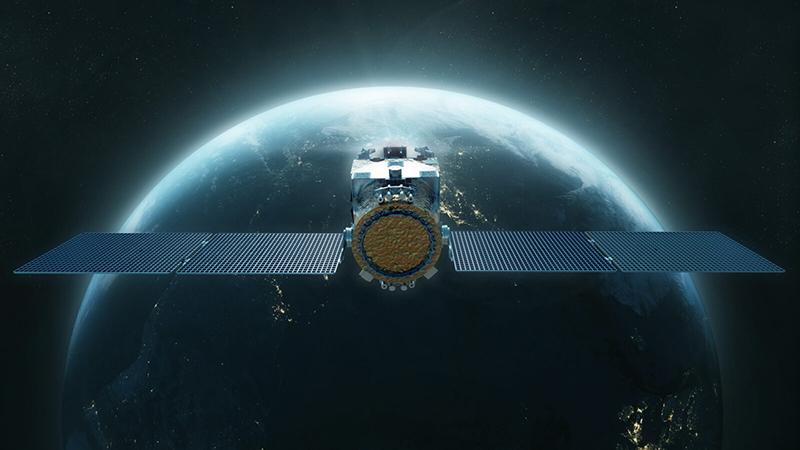Why Orbital Maneuvering Is Top Of Mind At U.S. Space Command

The Space Force has tapped Astroscale U.S. to build a prototype satellite that could refuel other spacecraft on orbit.
Western military space leaders are waking up to an uncomfortable reality: On-orbit threats to their space systems are here, but the ability to counter them may be a decade away.
Beijing has demonstrated proximity operations around some of its defunct spacecraft and operational Western satellites, military and civilian officials say. China also has launched satellites with robotic arms that the U.S. Defense Department has warned could be used to engage other spacecraft. Moscow has performed “nesting doll” operations where a smaller spacecraft emerges from a main satellite.
“We now face concurrent and accelerating threats in, from and to space,” Gen. Stephen Whiting, leader of U.S. Space Command, warned at the Defense in Space Conference in London in late September.
- Satellite missions are compromised by fuel supply
- Refueling and advanced propulsion tech is still years away
Whiting and other Western space leaders are calling for greater investment in “dynamic space operations” to monitor spacecraft in nonstandard orbits better and thwart a potential adversary’s ability to track, target, disable or defeat friendly assets. France is also pursuing in-orbit maneuvering systems to safeguard its satellites, and Germany is considering a similar effort (AW&ST Sept. 30-Oct. 13)
The U.S. Space Force for about a decade has been operating the Geosynchronous Space Situational Awareness Program satellites, which are capable of sustained maneuvering on orbit and designed to help the Defense Department track human-made objects in space more clearly than is possible from the ground. But the once-classified spacecraft are constrained by a limited fuel supply, and one satellite reached the end of its lifespan and was deactivated in 2023.
The Space Force “must operate until missions are complete, not until the fuel we launched with is depleted,” Whiting said.
Space Systems Command has made “a modest investment” into space mobility and logistics capabilities, says Lt. Gen. Philip Garrant, the command’s leader. It plans technology demonstrators to help inform requirements for dynamic space operations systems that can “maneuver without regret,” he said in a Sept. 18 media briefing.
In 2023, the command awarded Astroscale U.S. a $25.5 million contract to develop and build an in-space re-fueling spacecraft with a demonstration planned for 2026. The vehicle is being designed to travel directly to geostationary Earth orbit (GEO) with a full fuel load and would transfer hydrazine to a client spacecraft.
But Space Systems Command sees a 5-15-year gap before satellites can independently maneuver on orbit, Garrant said. In the meantime, he is focused on retrofitting legacy spacecraft to make them more resilient, “before these systems inherently do it themselves,” he added.
For Whiting, as a combatant commander, that is too long. “We need these systems delivered on accelerated timelines at scale,” he said, noting that on-orbit refueling and advanced propulsion technologies are already showing promise.
“I certainly recognize building some of those capabilities at scale and across multiple constellations will take years,” he told reporters. “But we think there might be opportunities earlier than that to help us to have sustained space maneuver.”
Currently, the orbital regimes where satellites operate—in low Earth orbit (LEO), medium Earth orbit and GEO—are distinct, Whiting said. But future threats will maneuver between them, he added, requiring new ways to respond. That is not a trivial technical challenge. LEO satellites operate at altitudes of around 300 mi., and those in GEO orbit at more than 22,000 mi.
The Space Force’s Commercial Space Office is seeking options for maneuverable satellites that can operate in GEO and plans to release a request for proposals in early 2025.
The program is modeled after a similar effort to procure commercial satellite communications (satcom) services in a proliferated LEO constellation, Col. Richard Kniseley, who oversees the project, told reporters during the Air and Space Forces Association’s Air, Space and Cyber Conference outside Washington. It is open to mission areas, including satcom; position, navigation and timing; and weather assets.
The Defense Department is also modernizing ground systems to enable future dynamic space operations. The Space Rapid Capabilities Office (RCO) is investing $1 billion over the next 5-7 years in a cloud-based infrastructure to replace two legacy platforms built to support positional satellites: the Enterprise Ground Services and the Ground Command, Control and Communications systems.
The Space RCO established the Rapid Resilient Command and Control (R2C2) program in February 2023 in partnership with Space Systems Command, which will primarily support new satellites built to protect and defend on-orbit assets, Col. Greg Hoffman, senior materiel leader for the office’s space acquisition delta, tells Aviation Week.
“Some of those satellites will have to move dynamically,” Hoffman says. “Sometimes they might flee or scoot. Sometimes they might move into a protection scheme. R2C2 is what enables that.”
The effort has resulted in a prototype that was built early this year. That infrastructure transmitted 11 commands to an on-orbit Space Force satellite in August, with each command acknowledged by the spacecraft. It also demonstrated rendezvous and proximity operations in a simulator.
Through R2C2, the Space RCO wants to acquire software systems in bite-size pieces for regular delivery of satellite operations capabilities to on-orbit mission partners. It is scaling that capability and recently awarded 20 small businesses a cumulative $12 million in initial delivery orders to help awardees familiarize themselves with the current prototype’s architecture and government processes.
The ground system is scheduled to transition out of prototyping and support limited on-orbit operations in the spring of 2025, Hoffman says.






